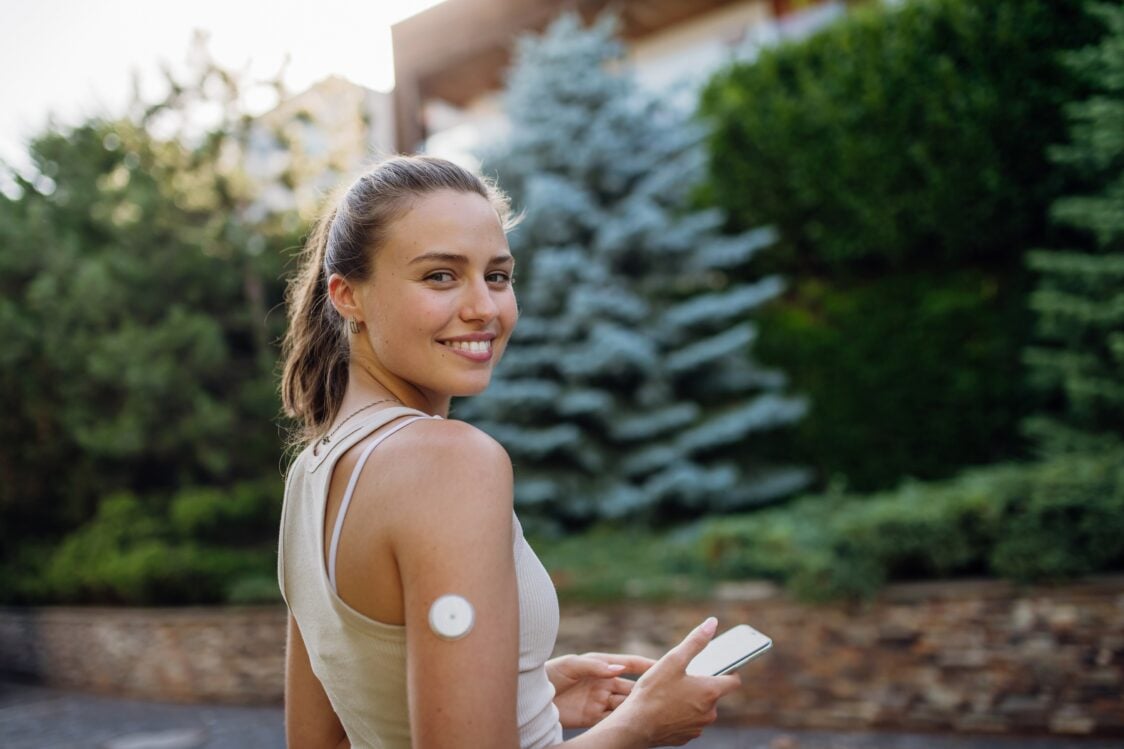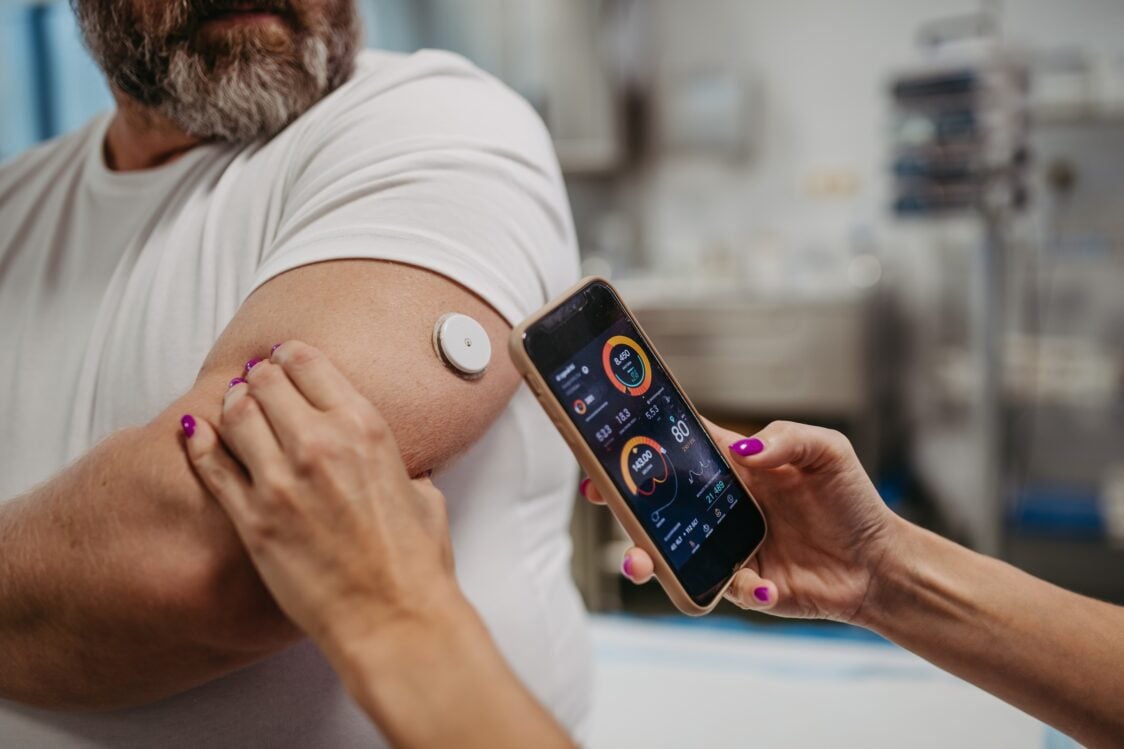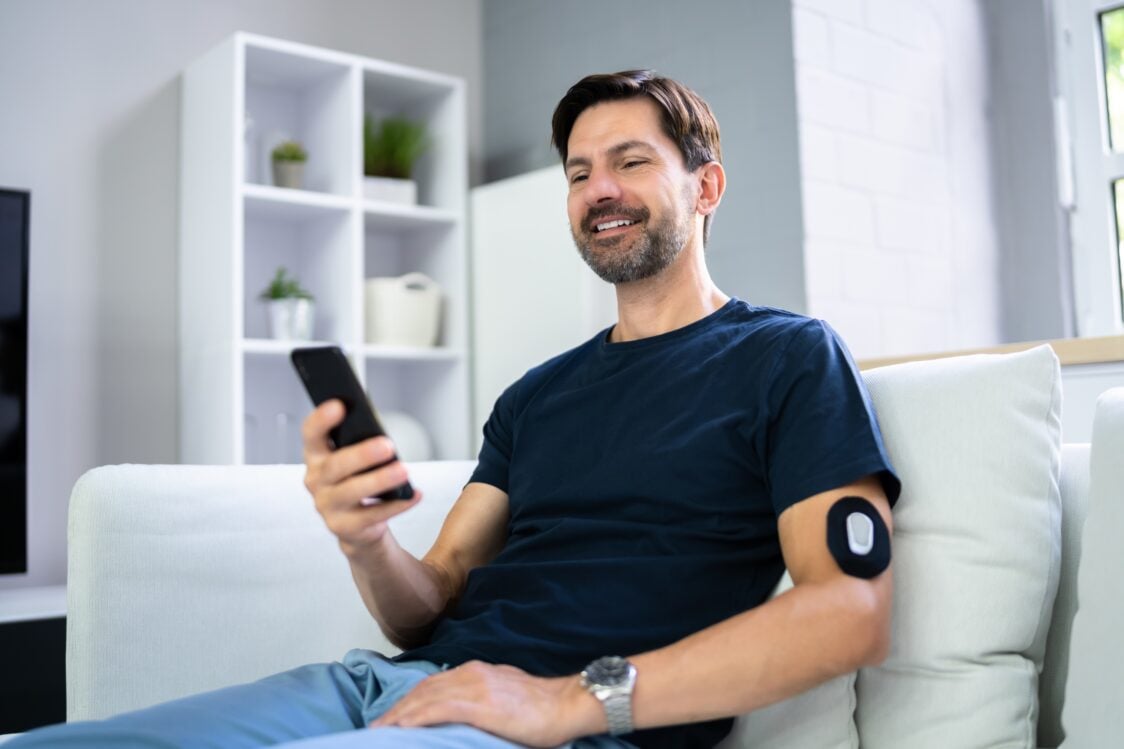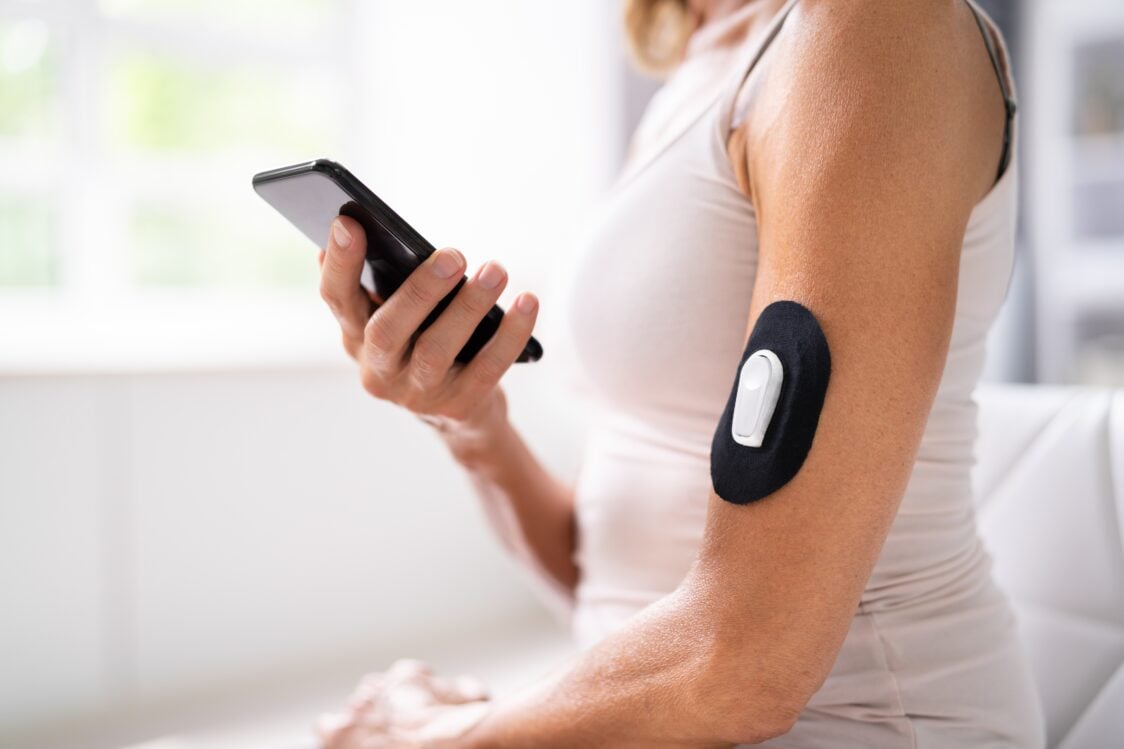Table of Contents
Do you also notice more and more people with a white band on their arm and you don’t know what it is? It’s probably not a super-modern chip, but rather a continuous glucose monitor. It’s a relatively new technology for measuring blood sugar levels. This device is mainly used by people with diabetes who need to keep a close eye on these readings. However, it has also quickly made its way into the radar of biohackers, technology lovers, and all other people looking for ways to promote weight loss or optimise their health. In today’s article, you’ll learn what’s behind the popularity of these devices, how they work, and who they’re suitable for.
What is a continuous glucose monitor (CGM)?
A continuous glucose monitor is a wearable device that monitors blood sugar (glucose) levels in real time. Unlike traditional glucose monitors, it provides data for the entire day, offering a more comprehensive view of blood sugar (“glycaemia”) trends. This allows a person to see how diet, exercise and other daily activities affect glucose levels. This data is especially valuable for people with type 1 and type 2 diabetes (diabetes mellitus) or other metabolic diseases. It is for them that this device was primarily designed. Recently, however, it has also been used by those who are healthy. For these people, it can provide interesting data that can be used to make positive lifestyle changes.[1]
What is the CGM composed of?
The most important part is the sensor, which consists of a thin fibre leading into the subcutaneous tissue. It sticks to the skin thanks to an adhesive circle, which is sometimes covered with a protective patch. The second indispensable component is the transmitter, which is part of the sensor and sends information about glucose levels via Bluetooth to an app installed on your smartphone. [1]

How does a CGM work?
The sensor, typically located on the arm or abdomen, measures blood sugar levels in the interstitial fluid. It doesn’t get readings directly from the blood as most people think. It collects readings from the interstitial fluid (tissue fluid) that permeates all tissues and fills the space between cells. This measures the glucose that leaks outside the blood vessels into these spaces. [1, 8]
The CGM is then pre-set to be able to assess blood sugar levels based on the amount of glucose in the interstitial fluid. Measurements are usually taken every 5-15 minutes.
Basic functions of a CGM
You can view the values collected by the device directly in the app. The specific features vary by manufacturer, but most often you will see the following options. [8]
- Display your current glucose value.
- Set alarms for hypoglycaemia (low blood sugar) or hyperglycaemia (high blood sugar).
- Trend arrows: estimate the direction of glycaemia. According to these, the next steps (food, physical activity) can be planned.
- Record information about activities that have influenced the development of glycaemia: for example, food (amount of carbohydrates), sport or sleep quality. Accordingly, you can better understand the influence of these factors on glucose levels and make better decisions in the future.

Is a CGM reliable?
Due to the fact that the device reads sugar levels in the interstitial space and not directly from the blood, many people question the accuracy of the values obtained. Sugar goes into the blood first and then into the interstitial fluid. This is why the values obtained have a delay of 10-20 minutes when compared to a measurement straight from the blood. So with a CGM the results are obtained a little later, but the accuracy of the measurement is not affected by this according to current information. [3]
However, in addition to the time lag, other factors must be taken into account that may bias the results. For example, while you sleep, the device may measure lower readings because you are lying on the sensor. Your body’s hydration and certain medications and supplements, such as acetaminophen (Tylenol), Aspirin or high doses of vitamin C, can also affect the readings. Therefore, a CGM is fairly reliable, but you need to be aware of the factors that can affect the readings. [3]
How is a CGM used?
The application and replacement of sensors varies from one manufacturer to another. Therefore, always follow the instructions listed for the specific device. Everyone is then interested to know if it hurts before attaching the CGM sensor itself. There is however nothing to worry about. Most people describe that the applicator makes the process quick and almost painless. [2]
- Wash and dry the skin where you will apply the sensor.
- Connect the sensor to the disposable applicator provided.
- Place on your body.
- Push ON the applicator to insert the sensor into the subcutaneous tissue with a thin needle and attach it to the skin.
- Only a thin fibre remains under the skin. The needle remains in the applicator.
- The sensor should be changed approximately every 14 days. Just peel it off and then attach a new one.
- Install the manufacturer’s recommended app on your smartphone and activate the new sensor.
- Then just hold your phone up to the sensor and you can start collecting data about your blood sugar.
- The frequency of data capture depends on the manufacturer, for instance it may be every 8 hours.

What to watch out for when using a CGM?
Manufacturers usually recommend to cover the sensor with a patch to protect it from damage and falling off. This is especially important when working out, swimming or any other activity. However, if you are going to have a medical examination using a device such as an X-ray, MRI or CT scan, you will need to remove the sensor beforehand. Radiation from the machines could damage it. [4]
What do you need to know before using a CGM?
Most people who use a CGM are concerned about how much their sugar rises after eating. This phenomenon is technically called postprandial hyperglycaemia. After you eat a meal containing carbohydrates, they are metabolised or broken down in the digestive tract into the most simple sugar (glucose). This is then released into the blood and interstitial fluid. The glucose monitor then informs the user that there has been an increase in glucose levels, which is a common physiological phenomenon. [9]
- A normal postprandial glycaemia value after 1-2 hours after a meal in healthy people is 140 mg/dL (7.8 mmol/L).
- In people with diabetes, it is higher than 180 mg/dL (10.0 mmol/L).
You might be interested in these products:
What affects glucose levels after a meal?
The most important factor that determines how much and for how long your blood sugar rises is the carbohydrate content of your food. For example, if you eat only a carbohydrate food (banana, fruit juice or smoothie), there will be a rapid rise, which in turn will be followed by a rapid drop in glycaemia. You may also see this as a rapid increase and decrease in energy.
However, there is also a difference in the type of carbohydrate you choose. Simple sugars, such as those from fruit or lollies, raise glycaemia faster than complex carbohydrates (polysaccharides) from wholemeal bread or oatmeal. Protein, fat or fibre, which take longer to digest and can also slow the absorption of carbohydrates, can also slow the rise in glycaemia. Thus, your best choice is a full complex meal, after which your energy will last longer.
However, you all know that nothing in the human body is simple, and glucose fluctuations are no exception. Glycaemia is also influenced by physical activity. When you go for a run, for example, you use your blood sugar as an energy source, which then translates into lower glycaemia levels. However, sleep, stress, or your body’s hormonal state can also affect these values. Recent studies have even found that the gut microbiome environment and genetics play a role as well. [9]

Why are we interested in glucose levels at all?
The amount of circulating sugar in the blood is not just a measure of how much energy you have available. How your glycaemia increases and decreases is one indicator of your health. High glucose levels (‘hyperglycaemia’), for example, are a major diagnostic criterion for diabetes. Hyperglycaemia is dangerous for the body as a whole. When there’s more sugar in your blood and your body doesn’t know what to do with it because your liver, brain or muscles simply can’t process any more, it can damage your blood vessels. And as you all know, there are blood vessels all over the body. That’s why diabetics have a higher risk of heart, kidney, nerve and eye disease. [13]
Should glucose levels be addressed by healthy people?
Recurring blood sugar spikes can cause problems even for people without diabetes. When your blood sugar rises after eating something sweet, for example, this is referred to as ‘blood sugar spikes’. However, these sugar spikes are not as sweet as they may seem. Not only are they followed by a rapid drop in sugar levels and therefore perceived energy, but current studies suggest that they may also be one of the causes of heart and blood vessel disease.[14–15]
In these studies, researchers also found an interesting fact. It turned out that even among healthy people there are differences in glucose metabolism. Thus, after the same meal, everyone’s sugar can rise a little differently. Some people have only slight fluctuations during the day and others have a roller coaster ride. Depending on how your sugar rises after a meal, you can classify yourself as a certain glycotype. This is why the need for a personalised diet, which a CGM can help with, is increasingly being discussed. [9, 16]

For whom are CGMs intended?
Continuous glucose monitors are one of the most innovative blood sugar measuring devices. These are primarily intended for people with impaired carbohydrate metabolism. They make it easier for them to check their glucose levels after meals and during the day. This allows them to keep a better eye on whether they are falling into dangerous hypoglycaemia or hyperglycaemia.
- Type 1 diabetics: For them, this device can greatly simplify and improve their lives, as they do not have to prick their finger or abdomen several times a day to check their glycaemia and administer their insulin dose accordingly.
- Type 2 diabetics, prediabetics, and people with insulin resistance: A CGM will help them gain more insight into how a particular food, sport or sleep affects blood sugar fluctuations. This will provide them with data that can motivate them to eat healthier and adjust their overall lifestyle. [7]
Impaired glucose metabolism, and in particular insulin resistance, often affects women with polycystic ovary syndrome (PCOS), so CGM can be one of the tools to help them with a personalised diet. [12]
Is the use of a CGM suitable for healthy people?
Does it make sense to monitor your glucose levels even if you don’t have diabetes? CGM devices have become another popular technological innovation that many people are hoping will give them more control over their health. For example, the goal may be to prevent diabetes in people who have a family history of the disease. Equally, with CGMs, they can better understand the impact of diet, exercise or psychological well-being on glucose fluctuations. Based on this, they can then optimise their diet, training and overall lifestyle. [10]
Healthy people can also benefit from the use of a CGM. However, especially in the beginning, a good dose of motivation, careful monitoring of data, and even keeping a record of your diet, workouts and other activities that could affect your glycaemia are needed. This is the only way to track how your body is functioning in the bigger scheme of things and make the necessary changes. Still, keep in mind that blood sugar levels are just one of many indicators of health and performance. It’s also important to note that in some countries, CGMs may only be available to people with diabetes or other metabolic diseases.

For whom are CGMs not suitable?
CGMs are perfectly safe for most people. The sensor only penetrates the top layer of the skin, so it is an almost non-invasive method. Even so, its application may be inappropriate for some people. [5–6]
- Those with allergies: The sensor material may cause an allergic reaction or skin irritation at the application site for some people.
- Injury at the attachment site: If you have a skin injury in the area where you want to apply the sensor, it is better to choose another part of the body. This could cause a distortion of the results and also a higher risk of infection.
- Poor user compliance: CGMs require regular replacement, sometimes calibration by the user, and a general willingness to be responsive to measurement results. Thus, they are not suitable for people with neurodegenerative or psychiatric illnesses who might react poorly to the placement of the device on the body.
- People who don’t want to have devices attached to their body: Some people may be uncomfortable with a sensor permanently placed on the arm or elsewhere on the body for various reasons.
- People with an eating disorder: These people are at risk of an excessive focus on numbers and the need for excessive dietary control. They may get the feeling that everything they eat is bad for them. [11]
What are the advantages of using a CGM?
The use of continuous glucose monitors is a relatively new phenomenon, especially for healthy people. Therefore, it cannot yet be said with certainty what the benefits are, especially in the long term. However, what has been found so far suggests a number of potential health benefits. Let’s take a closer look at them.
1. Stable glycaemia
By using a CGM and evaluating the impact of diet, exercise or sleep, you can make changes in your lifestyle that lead to less glycaemic fluctuations. In studies, the positive effect was particularly confirmed in diabetics who had lower HbA1c (glycated haemoglobin) values, a long-term indicator of sugar metabolism, after 3 months of CGM use. They also had a reduced incidence of dangerous hypoglycaemia. [22]
For healthy people, a more balanced sugar level also has a number of benefits. You can see it in a more constant energy supply throughout the day, fewer hunger and sweet cravings, better concentration or a more stable mood. Think about how other lifestyle factors, such as sleep quality or stress, affect these areas as well. [23]

2. Healthier diet
With a CGM, you can observe how your body reacts to certain foods and adjust your diet accordingly. If you eat a predominantly carbohydrate diet with a high proportion of simple sugars, you may see high blood sugar fluctuations. An example of such a diet is cereal and juice for breakfast, pizza and coke for lunch, a candy bar for snack, and bread and butter and salami for dinner.
However, if you add more protein, fibre, healthy fats and reduce carbohydrates and overall energy intake, you may see more balanced glucose levels. Such an effect has also been observed in studies where people have made exactly these changes based on the monitoring of CGM readings. Such a change typically also leads to less energy fluctuation throughout the day, less hunger, and an overall healthier diet containing the necessary macro and micronutrients. [17]
If you want to learn more about how to eat right, check out our article What Is a Healthy Diet and How to Learn to Eat Healthily?

3. Weight loss
Weight loss is another effect that people promise themselves from the use of a CGM. Blood sugar monitoring alone is not enough to lose excess kilos, you always need to meet the calorie deficit condition (energy expenditure is higher than energy intake). However, if the CGM data motivates you to make dietary changes in terms of adding a good source of protein, healthy fats and fibre, and substances that dampen glucose fluctuations, this will probably translate into a reduction in calorie intake.
At the same time, you may find that physical activity will also help you lower your glucose levels in the long run. You will start to move more often, which will in turn increase your energy expenditure. These are admittedly known facts that you know already without the use of CGM. However, when you observe it on your own body and see the results of your change immediately in the app on the glucose curve, it can give you a real kick in the pants and help you persevere with any changes. [18–19]
If weight loss is your goal, you should not miss our article Simple Weight Loss Basics? You May Be Surprised What’s Really Important.

4. Sports performance
Using a CGM can motivate you to exercise regularly, which in the long run promotes healthy glucose metabolism and balanced glycaemia. However, you can also use the data to benefit your athletic performance. Active individuals can track the effect of eating before, during and after workouts on glycaemia and body function. [19]
The manipulation of the amount and type of carbohydrates, which serve as the primary source of energy, makes the most sense. Some may confirm that they are most comfortable with quick carbs such as energy gels or maltodextrin. This is because these raise blood sugar levels the quickest and can be used almost immediately as a source of energy for physical activity. But then they can cause glucose to drop again quickly, which is not desirable for endurance performance. In this case, complex carbohydrates (oatmeal, rice sandwiches, baked goods) from which glucose is released gradually may be a better choice. With a CGM, athletes can confirm what suits them better and thus do not have to make decisions based on feelings alone. [20]
Glycaemic monitoring can also help athletes prevent low blood sugar (hypoglycaemia), which can lead to a drop in performance and fatigue. With the app’s readings, they can more easily identify the cause of a failed workout and assess, for example, that they probably ate too little beforehand and their sugar dropped as a result. They can then make changes to their diet in the future based on these insights, which can translate into better performance. [21]
However, the use of a CGM is just one factor that can optimise athletic performance. In fact, blood sugar level alone is not the only indicator by which to workout and eat. Rather, it is a tool for elite athletes who are fine-tuning their strategy for training and competition.
Supplements may also help you improve your sports performance:
- If you are into endurance activities, you will find the most effective ones in this article 11 Dietary Supplements for Running, Cycling and Other Endurance Sports.
- For fans of weight training and other sports, we have this article Basic Supplements for Working Out and How to Know Your Way Through Them?

5. Greater motivation and sense of control over your health
Even 10 experts who tell you what to do for your health probably won’t convince you as much as your own experience. When you can see the effect of a change you’ve made directly in the app, it gives you a good boost of dopamine and motivation. This will probably kick-start you into making more changes or maintain the current ones. In this way you can gain at least partial control over one of the most important health parameters.
Self-discipline is important in achieving any goal. Learn how to build and maintain it in this article Self-discipline: The Key to Success in Sport and Life.
Discover our bestsellers:
What are the disadvantages of using CGM?
Blood sugar levels are just a small slice of the great lifestyle pie. While the use of modern technology can help you make informed decisions, it also has its pitfalls.
1. Glycaemic monitoring is not self-sustaining
Your health is not only affected by blood sugar fluctuations. For example, if you have 5 eggs with bacon and butter and a small amount of vegetables, you will see that your blood sugar has not risen too much. But that doesn’t mean that such a meal is ideal for your heart and blood vessel health. That’s why, for example, diabetics are not only concerned with the amount and type of carbohydrates, but also the inclusion of appropriate sources of protein, fat, fibre and other necessary substances. A comprehensive approach is always needed, in terms of diet, sports and other lifestyle areas.
2. Excessive diet control
Even if you’re trying to eat as healthy as possible, don’t forget that food isn’t just about calories, nutrients and its effect on glycaemia. You should still enjoy it, indulge in it with loved ones, and not just worry about how it fits into your daily intake. Even if it’s your priority to create the ultimate tailor-made diet, it shouldn’t control your life.
Trying to keep your blood sugar levels balanced at all costs is not sustainable, and you may miss out on the joy of eating. Over time, it could even develop into an eating disorder. Think about the fact that if you are physically active and healthy, you can indulge in some sweets or dessert after lunch from time to time.

3. High financial burden
Because of their high price, CGMs are not available to everyone. Only in some countries can insurance companies cover the purchase of these devices, and usually only for type 1 diabetics. [24]
4. More complex evaluations
Especially in the beginning, it will be more challenging to understand the workings of a CGM and everything that can affect glucose levels. This can make it more difficult for someone without a basic understanding of nutrition and human physiology to evaluate the monitoring data and respond with the appropriate modifications.
5. The need to wear the sensor on the body
Some people may also be bothered by having to wear the sensor attached to their body at all times. This can be an aesthetic problem and also a source of prying eyes and questions from those around you. You also need to keep the sensor in mind during workouts so that you don’t accidentally knock it loose. [24]

What should you remember?
Continuous glucose monitors are one of those modern technologies that allow you to make an informed decision and support your health. For type 1 diabetics in particular, it is a breakthrough device that can make everyday life easier and help prevent dangerous hypoglycaemia. However, it can also benefit healthy people. By monitoring the data from a CGM, one can adjust their diet, physical activity and other areas of their lifestyle, which can result in better health as a result. Also, athletes can use glucose monitoring to benefit their performance both during training and competition.
Did you enjoy today’s article and did you learn anything new? We’d love it if you shared it with your friends and family!
[1] National Institute of Diabetes and Digestive and Kidney Diseases. Continuous Glucose Monitoring—NIDDK. – https://www.niddk.nih.gov/health-information/diabetes/overview/managing-diabetes/continuous-glucose-monitoring
[2] Nutrisense. How to Wear a CGM. – https://www.nutrisense.io/what-is-a-cgm/how-to
[3] Turner, M. R. and L. Are continuous glucose monitors (CGMs) accurate? – https://www.mysportscience.com/post/are-continuous-glucose-monitors-cgms-accurate
[4] The FreeStyle Libre System. Safety Information. – https://www.freestyle.abbott/us-en/safety-information.html
[5] The Case for CGM: Who May Not Be a Good Candidate for CGM? Silver Fern Healthcare. – https://blog.silverfernhealthcare.com/the-case-for-cgm-who-may-not-be-a-good-candidate-for-cgm/
[6] diaTribe. Does Your Diabetes Device Bother Your Skin? – https://diatribe.org/does-your-diabetes-device-bother-your-skin
[7] Jackson, M. A., Ahmann, A., & Shah, V. N. Type 2 Diabetes and the Use of Real-Time Continuous Glucose Monitoring. – https://doi.org/10.1089/dia.2021.0007
[8] Freckmann, G. Basics and use of continuous glucose monitoring (CGM) in diabetes therapy. – https://doi.org/10.1515/labmed-2019-0189
[9] Jarvis, P. R. E., Cardin, J. L., Nisevich-Bede, P. M., & McCarter, J. P. Continuous glucose monitoring in a healthy population: Understanding the post-prandial glycemic response in individuals without diabetes mellitus. – https://doi.org/10.1016/j.metabol.2023.155640
[10] Klonoff, D. C., Nguyen, K. T., Xu, N. Y., Gutierrez, A., Espinoza, J. C., & Vidmar, A. P. Use of Continuous Glucose Monitors by People Without Diabetes: An Idea Whose Time Has Come? – https://doi.org/10.1177/19322968221110830
[11] PCOS Nutrition Center. Continuous Glucose Monitors for PCOS. – https://www.pcosnutrition.com/continuous-glucose-monitors-for-pcos/
[12] Tao, M., Zhou, J., Zhu, J., Lu, W., & Jia, W. Continuous glucose monitoring reveals abnormal features of postprandial glycemic excursions in women with polycystic ovarian syndrome. – https://doi.org/10.3810/pgm.2011.03.2277
[13] University of Cambridge. DNA discovery highlights how we maintain healthy blood sugar levels after meals. – https://www.cam.ac.uk/research/news/dna-discovery-highlights-how-we-maintain-healthy-blood-sugar-levels-after-meals
[14] How Do Blood Sugar Spikes Affect Heart Health? – https://zoe.com/learn/blood-sugar-spikes-heart-health
[15] News Center. Diabetic-level glucose spikes seen in healthy people. – http://med.stanford.edu/news/all-news/2018/07/diabetic-level-glucose-spikes-seen-in-healthy-people.html
[16] Attia, P. Continuous glucose monitoring to improve health in non-diabetics. – https://peterattiamd.com/cgm-in-non-diabetics/
[17] Ehrhardt, N., & Al Zaghal, E. Continuous Glucose Monitoring As a Behavior Modification Tool. – https://doi.org/10.2337/cd19-0037
[18] Hegedus, E., Salvy, S.-J., Wee, C. P., Naguib, M., Raymond, J. K., Steven Fox, D., & Vidmar, A. P. Use of Continuous Glucose Monitoring in Obesity Research: A Scoping Review. – https://doi.org/10.1016/j.orcp.2021.08.006
[19] Kim, Y.-I., Choi, Y., & Park, J. The role of continuous glucose monitoring in physical activity and nutrition management: Perspectives on present and possible uses. – https://doi.org/10.20463/pan.2023.0028
[20] Perishable. Will continuous glucose monitoring improve my performance? – https://www.usada.org/spirit-of-sport/glucose-monitoring-performance/
[21] Askerjeukendrup. How can CGM be used? – https://www.mysportscience.com/post/how-can-cgm-be-used
[22] Kant, R., Antony, M. A., Geurkink, D., Gilreath, N., Chandra, L., Zipprer, E., Munir, K. M., Chandra, R., Parker, V. G., & Verma, V. Real-time continuous glucose monitoring improves glycemic control and reduces hypoglycemia: Real-world data. – https://doi.org/10.1016/j.pcd.2022.09.005
[23] Center, K. 7 Benefits of Stable Blood Sugar. – https://kaplanclinic.com/7-benefits-of-stable-blood-sugar/
[24] Karakuş, K. E., Sakarya, S., Yeşiltepe Mutlu, G., Berkkan, M., Muradoğlu, S., Can, E., Gökçe, T., Eviz, E., & Hatun, Ş. Benefits and Drawbacks of Continuous Glucose Monitoring (CGM) Use in Young Children With Type 1 Diabetes: A Qualitative Study From a Country Where the CGM Is Not Reimbursed. – https://doi.org/10.1177/23743735211056523


Add a comment